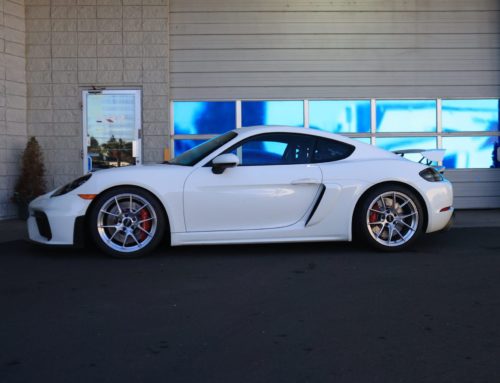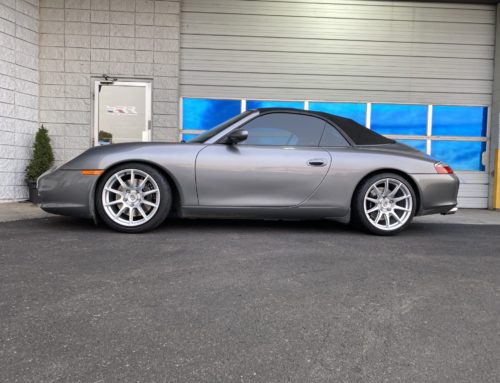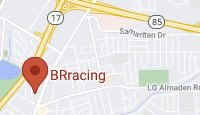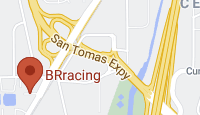Porsche GT4 – PHASES
The Porsche 981 GT4 has become one of “the” dual duty cars to have if you go to the track. Porsche did more upgrades and changes to this car than almost any other car on the market today to make this car truly track ready. All the major categories and boxes were checked with this car: seats, shifter, manual transmission, auto blipper, suspension bushings, coil-overs, exhaust, wheels, tires, adjustable control arms, underbody stiffening / supports, air ducts, brakes, cooling, brake cooling, aerodynamics, weight reduction…wow, what did they not do?
However, it was a great shock when we got our hands on the first one (Nov 2015), and we encountered the handling of the car. Not on the track only, but on the street. The stock car is HORRIBLE in terms of setup. Now, how could this be? How could Porsche spend all the time, thought, research, testing, and have a car that even on the street is horrible to drive aggressively? When driven on the track in anger, these traits come out even more. When we first mention this to new GT4 owners, they look at us in complete dismay…..”you must be wrong, this car is great.” The stock car is great, but once you start to push it, there are ugly elements of the handling. If you only drive to about 90% of the cars capability on the track, these don’t jump out at you, and that’s why many customers are not aware of the issues, as they are still learning the limits and personality of the car. But, these issues also show themselves quite quickly on the street. Take a freeway off ramp at speed…and the car will understeer badly on entry, and when you manage yourself thru the middle of the turn, and then want to get on it, the tail wants to take the lead. These are both horrible issues…and rob the driver of the great driving experience. On the track, they start to frustrate you highly, and rob the driver of having confidence in the car.
The good news is that these issues are easily addressed. Besides our experience in winning the Pirelli Drivers Cup Championship in the new Porsche GT4 Clubsport (2016), we have amassed a huge amount of time playing with both the race version as well as the street version. I think we have seen every color of street GT4 as well. This has allowed us to methodically attack the issue, and develop a long list of enhancements and setup changes to allow us to adapt the car to the customers specific use needs. Some of our customers are using the car mostly for daily driving, some are using it as their primary track weapon. There is a large variance in the specific needs of these two extremes. By having so many customers w the GT4 car, we have been able to collect a large amount of data…which is the real key to knowing what works, and not just doing the normal upgrade things that some shops do. This has also allowed us to develop a set of PHASES…and the reason behind this www write up…so that we can detail what changes and upgrades are needed for each customer case.
As originally mentioned, the stock car has a lot of enhancements that support the use of the car for track purposes, and make the car a little more hard core than your normal street sports car. Here is some insight into those upgrades that are present on the GT4:
Coil-overs / solid strut mounts
The GT4 comes stock w ride height adjustable coil-overs, front and rear. Different shock settings than the other Caymans, different spring rates. This is not revolutionary, but welcome, but the combination of also have solid mono-ball upper strut mounts make this more of a track setup than a street setup.
Front Coil-Over
Rear Coil-Over
Rear upper strut mount – solid bushing (same type on the front as well)
Manual transmission w “auto-blip” downshift
More and more of the cars are coming w PDK, or dual clutch paddle shifting systems. The hardcore sports car driver still longs for the interaction and joy of shifting manually. Well, Porsche delivered just that, a manual shifting transmission, strong clutch, and enhanced the whole experience w the “auto-blip” rev matching on down shifts. Some drivers were better at “heal and toe” downshifts, some not so good. So, Porsche solved that with the “auto-blip” rev matching. It is truly amazing…even the best “heal and toe” drivers smile at the implementation.
Seats
You can order your GT4 w the Porsche Carbon Fiber Sport Buckets. These are the fourth generation of the Porsche light weight carbon fiber sport seats, and these are the versions first seen on the Porsche 918 Supercar. Amazing seats. Fit is perfect, they now incorporate cutouts for the stock seat belt receivers, but are one piece, not 2 piece like the prior generation. They have the shoulder cut-outs for harness implementation (actually, 2 sets of them, to provide for the right height alignment for the multitude of drivers), along w slightly larger holes for lap belts to allow for harnesses, and the submarine cut-out too.
Body – cooling, reinforcements, hydraulic engine mounts, transmission cooler
Porsche went way beyond what you see in other upgraded street sports cars. They paid attention to the little details, but many of the items that affect the long term use of a car on the track — underbody supports, structural upgrades, brake cooling ducts (front and rear), even things like screening of the front radiator cutouts.
Rear Underbody View – rear brake duct, added (stock for GT4) underbody bracing, long trailing arm
Transmission cooler (liquid heat transfer)
Hydraulic engine mounts
Suspension – bushings, adjustable control arms, solid mounts, solid toe links
Rear stock toe link – solid inner and outer ball joints
Stock front thrust arm bushing (rubber)
Front lower control arm (2 piece, adjustable length) w litronics arm (ride height sensor)
Rear lower control arm, solid trailing arm bushing
Rear adjustable, 2 piece lower control arm, rear sway bar, bigger mounts
Front inner fender liner radiator duct screening
Tires – Michelin Pilot Sport Cup 2
The car comes with Michelin Pilot Sport Cup 2…and they are amazing. Amazing that they are street tires. But, if you hammer and beat on your GT4 at the track regularly, like many do, then you may want to consider some alternative tires…as we have found that, when driven really hard, the Pilot Sport Cup 2’s only last about 3-4 track days. Many customers would like a little longer life, and may be willing to give up some grip for the longer life. In that case, we recommend the Bridgestone RE71R. This has been a new tire in 2016, and has become quite a track mainstay, and comes in the right sizes. So, choose your weapon / tire of choice.
So, there we have it…an amazing car, with a long list of upgrades over most street cars. But, it doesn’t cut it. Changes are needed…
PHASE 1

As mentioned in the start of this article, the handling should be great. Mid-engined car, upgraded parts, stiffened body, auto-blipping manual transmission. But, for a reason we don’t understand, they left the stock car screaming for help in the handling area. The good news is that you DO NOT NEED new parts to help transform the handling for most users. You just need to change the alignment. Given the upgraded parts that come with the GT4, what we need is already there…we just have to tune it. We have come up with four phases of alignment adjustment, to align with customers use / needs / driving style. Most alignment adjustments need to take into consideration the balance between daily driving and track use, and if a customer values tire life more than handling benefit.
Alignment – Phase 1a – starting point.
For most, we have found the starting point a relatively aggressive front and rear camber (the specific specs are part of our intellectual property), the balance between front and rear is important, and a small adjustment to the toe settings (front and rear). It is similar to the changes we found the GT3 / GT3 RS / GT2 cars needing, but given it is a mid-engined car, the balance is different.
Alignment – Phase 1b
This now requires some upgraded parts. There is not enough adjustment available in the rear toe-links to achieve the desired results. Its not the toe settings themselves, but as you increase rear negative camber, you push the rear hub out, requiring a longer toe link to achieve the toe settings. The stock toe link is awesome, as it has solid bushings, but just not enough range of adjustment or length. You can replace the rear toe links w either after market units, or with Porsche Motorsport GT4 ClubSport units. Both toe link units are unique (either an aftermarket unit like Tarett Engr, or the Porsche Motorsport GT4 ClubSport unit), in that the inner subframe is a Cayman, while the outer hub is a GT3 unit. If you go the route of the GT4 Clubsport units (our preference due to the adjustment hardware), then the mounting to the outer GT3 hub needs to change.
Porsche Motorsport rear adjustable toe links, front upper solid strut mounts, special hardware
Porsche Motorsport ClubSport rear toe link

Besides the hardware needed, a slight adjustment to the “rake” of the car needs to be implemented. As the customers start to push the car harder, we need the “front / rear” balance to assist in corner entrance and corner exit. This is easily accomplished since the car has adjustable coil-overs front and rear. If this were like most street cars, this slight adjustment would require new coil-overs to be installed…but not on the GT4.
Alignment – Phase 1c
Porsche Motorsport front upper strut mount (left), stock Porsche GT4 upper mount (right)
More parts needed. There has been write up by Manthey Racing (the outside racing team of Porsche) on some of the limitations of the stock GT4 suspension. As you try to increase the alignment settings, you run into limitations, and some safety issues. If you use the stock adjustable front lower control arms to increase camber, you will also push caster out of whack, and likely will have rubbing issues on the front inner fender liner…just where those nice Porsche integrated radiator screens are. Not what you want. Therefore, you need to change the upper strut mounts. This adds some natural negative camber, and also caster fix. Pay close attention to the rear camber adjustment as well….as the rear trailing arm will start to come too close to the inner body, and if this touches (which is possible under load), then this can cause structural fracture.
Alignment – Phase 1d
More parts needed. Not just for alignment, but for confidence when driving. These are the thrust arm bushings, and their adjustment. For a reason we don’t understand, Porsche included solid rear trailing arm bushings, but on the front, for the thrust arms, they are rubber…..WHY? So, out w those, and in go adjustable, solid thrust arm bushings.
This now provides two benefits….more adjustability, both for caster….and wheelbase. Yes, another one of those little things that can benefit the handling is a change in the overall wheel base of the car. Changing the front thrust arm bushings eliminates the front “toe steer”, that happens under hard braking and the front bushings deflect / compress, changing the toe as they do, and the car feels as though it is steering on its own…very unsettling…but easily altered by the replacement w solid front thrust arm bushings.
PHASE 2
Now that we have the alignment improved, the car now handles the way we want hope and want…it turns in great, hunts for the next turn, is balanced in the middle of the corner, and whenever we mash the fast pedal, the car takes it all in stride, and gets on with delivering the power to exit the corner, and get on with the mad rush of driving fast. But, if we are now starting to drive fast….really fast, then we need to add the safety elements to the car. In Europe, you can get the GT4 w a roll bar and harnesses…but not here in the States. So, we need to do that, and we will carry it even farther, adding the roll bar / harness bar, harnesses, but also the option for upgraded seats. If you have gotten to where this is becoming your dedicated track car, then the seats too can be improved over the amazing Porsche Sport Bucket seats…as they were meant to provide dual duty (street driving, track driving). Taking the lead from Porsche themselves….when they implement harnesses at the factory, they do it by mounting the shoulder harnesses to the rear bulkhead…which provides for the right down angle from the seat shoulder harness openings to the mounts, and also eases future adjustment.
This will open up the question of which roll bar / harness bar. There are about 4 different versions on the market as of this writing, and we have measured / examined them all (GMG, BBi, Cantrell, BGB Motorsports). Each has indeed taken a slightly different implementation. Some mount to the lower frame rail (GMG), some to the upper bulkhead (all others), some have a harness bar that goes thru the center interior panel, some are above it. Some have lower angles in the downbars (in our view, not desired), some require more modification of other interior panels (making it less reversible for when you go to sell the car). Most of all, safety is the key, and so we have looked at them all, and currently we believe the GMG bar, along w the custom shoulder harness mounting is the right approach (the GMG bar does have a horizontal harness bar element, but this puts the shoulder harness attachment point above the cut-outs in the seat….not ideal). We like that the GMG bar doesn’t require cutting of the other body panels, and we like the down bar angle vs the main hoop…this provides more rigidity and strength. We’re ambivalent on the main hoop mounting location (upper bulkhead vs lower frame rail…..and, we do have direct evidence, real life experience w the attachment to the lower frame rail providing more than sufficient strength to protect in a roll over…as we have had two customers roll their cars (and if you wonder if you need a roll bar even for just normal DE (driving event) days…the answer is YES)), that had the GMG bars installed, and both were able to get out of their cars, open the side doors, and had no injuries).
GMG Cayman GT4 roll bar / harness bar
Area behind the front seats, rear bulk head, w console and padding removed.
Harness mount hardware for both sides
Shoulder harness mounts. Note, due to uneven surfaces, BRR installs, then injects epoxy on both sides to fill in uneven surfaces, and create a solid, composite structure.
GMG main hoop lower mount (into outer frame rail)
GMG roll bar / harness bar, harnesses all installed
Tight clearance / tolerances of the GMG bar w the headliner.
RaceTech 4009 seats, Schroth harnesses, Porsche Motorsport sliders, GMG seat bases
GMG roll bar allows the seats (stock or aftermarket), to slide all the way back without interference
PHASE 3
Brakes. The stock brakes are just fine (other than wear and cost). The car can come w either steel rotors / pads, or the Porsche Carbon Ceramic (PCCB) braking system. Most track oriented users opted for the steel rotor / pad setup, many for the reason of cost and cost of repair / replacement. Many still hold that the PCCB system should be great, and should last….I love how they say it “should”….but as evidence piles up, the PCCB don’t last, and when it comes time to replace them (a whole different subject)…then, you either need to be massively rich, or rob a bank.
So, for the avid track user…we need to slightly upgrade the brakes. The calipers are fine, the brakes have great built in cooling, both front and rear. But, the rotors and pads need to change. We opted for the Giro-disc 2-piece rotors (front and rear), and a set of Endless ME20 pads. We also like the RaceTech TS20 pads for dual duty.
Giro-disc 2 piece hat / rotor, Endless ME20 track pads, Endless RF650 or Brembo HTC 64T brake fluid
PHASE 4
One of the first questions we often hear out of a customers mouth, is “what can we do for more power?”. With many “naturally aspirated” engines, there is not much you can really do. However, w this engine, and given that Porsche didn’t mind if they did some things that took a little power away from the car (didn’t want it to encroach on the real track car, the GT3), there is some room and things you can do to increase power. What can you do??? Headers, and a DME / CPU software tune. If you really want more power, you can work w the intake system as well…but there are not any current “bolt on” products that do the trick.
Not only do headers offer more power, they also solve a problem. The stock headers, under full load or wide open throttle at the track, get very hot, and that heat propagates to the shocks, and the wiring harness for the ignition coils. Bad things then happen…the ignition coil wiring harness melts, and the shocks “sag” or become soft. New headers solve this issue, and provide more power…right when your right foot wants it. Now….add a “tune” to this, and you have a real change in the power of the car, and a much more responsive car. For the tune, we use Cobb’s AccessPort.
GMG GT4 headers (left), Porsche GT4 headers (stock, right)
Issues have been encountered w the stock headers, heat shields, welds
GMG headers installed
That’s all it takes. There is still more… but for most of our customers, the list of upgrades / enhancements / changes fits the bill for their use. Don’t delay…and don’t leave your GT4 stock..there is so much more fun to be had.
BRracing – building excitement














































